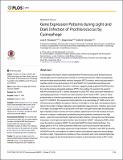Gene Expression Patterns during Light and Dark Infection of Prochlorococcus by Cyanophage
Author(s)
Thompson, Luke Richard; Zeng, Qinglu; Chisholm, Sallie (Penny)
DownloadThompson-2016-Gene Expression Patterns during.pdf (3.138Mb)
PUBLISHER_CC
Publisher with Creative Commons License
Creative Commons Attribution
Terms of use
Metadata
Show full item recordAbstract
Cyanophage infecting the marine cyanobacteria Prochlorococcus and Synechococcus require light and host photosystem activity for optimal reproduction. Many cyanophages encode multiple photosynthetic electron transport (PET) proteins, which are presumed to maintain electron flow and produce ATP and NADPH for nucleotide biosynthesis and phage genome replication. However, evidence suggests phage augment NADPH production via the pentose phosphate pathway (PPP), thus calling into question the need for NADPH production by PET. Genes implicated in cyclic PET have since been identified in cyanophage genomes. It remains an open question which mode of PET, cyclic or linear, predominates in infected cyanobacteria, and thus whether the balance is towards producing ATP or NADPH. We sequenced transcriptomes of a cyanophage (P-HM2) and its host (Prochlorococcus MED4) throughout infection in the light or in the dark, and analyzed these data in the context of phage replication and metabolite measurements. Infection was robust in the light, but phage were not produced in the dark. Host gene transcripts encoding high-light inducible proteins and two terminal oxidases (plastoquinol terminal oxidase and cytochrome c oxidase)—implicated in protecting the photosynthetic membrane from light stress—were the most enriched in light but not dark infection. Among the most diminished transcripts in both light and dark infection was ferredoxin–NADP[superscript +] reductase (FNR), which uses the electron acceptor NADP[superscript +] to generate NADPH in linear photosynthesis. The phage gene for CP12, which putatively inhibits the Calvin cycle enzyme that receives NADPH from FNR, was highly expressed in light infection. Therefore, both PET production of NADPH and its consumption by carbon fixation are putatively repressed during phage infection in light. Transcriptomic evidence is thus consistent with cyclic photophosphorylation using oxygen as the terminal electron acceptor as the dominant mode of PET under infection, with ATP from PET and NADPH from the PPP producing the energy and reducing equivalents for phage nucleotide biosynthesis and replication.
Date issued
2016-10Department
Massachusetts Institute of Technology. Department of Biology; Massachusetts Institute of Technology. Department of Civil and Environmental EngineeringJournal
PLOS ONE
Publisher
Public Library of Science
Citation
Thompson, Luke R., Qinglu Zeng, and Sallie W. Chisholm. “Gene Expression Patterns during Light and Dark Infection of Prochlorococcus by Cyanophage.” Ed. Douglas Andrew Campbell. PLOS ONE 11.10 (2016): e0165375.
Version: Final published version
ISSN
1932-6203